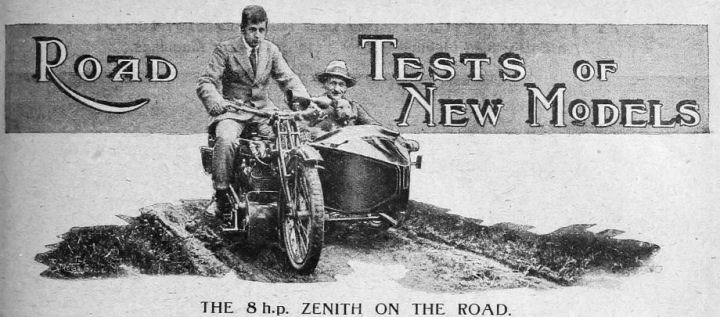


IT is a remarkable tribute to the efficiency of the Gradua gear that it has been continually on the market, with very few modifications, for the last ten or twelve years. The fascination of driving a machine with a gear which is infinitely variable between two points is certainly very great, and if the difficulties usually attending belt drive are overcome it still remains, on account of its smoothness, the most delightful form of transmission.
Our experience of the latest model Zenith tends to show that the designers in this case have eliminated the more serious of their drawbacks, i.e., belt-slip, due to microscopic pulleys, and inability to gear under about 7 to 1. Of course, this improvement was effected by the introduction of the forward countershaft.
Absence of Belt Slip.
The machine was used mainly for business purposes, and on two occasions carried the rider and passenger over a forty-mile cross-country road which contained one or two rather steep hills, to Brooklands, while much of the journey was over narrow winding lanes with bad surfaces. Previously the rider had found it difficult to cover the forty miles in less than two hours, but with the Zenith on a certain night, when it poured with rain, and in consequence very few people were about, the time taken to accomplish the journey was very considerably shortened. People will at once imagine that with a machine fitted with belt drive the belt would slip seriously under these conditions, as the roads were literally swimming with water, but we are glad to say that this was not so, even though the belt was put on new that afternoon, and the initial stretch had not been taken out of it. Needless to say the belt did require adjusting the following morning, but the fact remains that it held perfectly through the torrential rain encountered on that drive.
A Semi-automatic Carburetter.
The J.A.P. engine fitted to this particular machine was remarkably smooth, being beautifully balanced, reasonably flexible, and giving ample power. The carburetter was a 1920 Amac, which provided delightful flexibility from about fifteen miles an hour to the maximum speed of which the machine was capable, but as it was adjusted, at small throttle openings the firing was apt to be erratic and the mixture extremely difficult to find, which proved to be rather troublesome in traffic. In the open country, on the other hand, the air could be placed fully open and the carburetter was then practically automatic in action.
Saddle Suspension.
The machine was exceedingly comfortable, and this was very largely due to the patent system of saddle springing which is the invention of Mr. F. W. Barnes. The saddle is suspended on quarter-elliptic leaf springs, and is hinged at the rear so that the top can be inverted in case of wet weather, thus keeping the seat dry for the rider. The system efficiently absorbs all road shocks, and with it a broken spring should be impossible. The spring forks are also most comfortable. As a great deal of our riding was done over rough roads we are well qualified to speak of the excellence of these fitments.
The Zenith Big Twin has undoubtedly advantages over many of the heavier machines of equal horse power which are now upon the market; it is obviously lighter on account of the absence of a heavy gear box, with the result that the speed and acceleration are all that can be desired. During the two or three hundred miles we drove the machine we were certainly delighted with it, and also with the sidecar (a Millford) which was comfortable and well sprung.
The Motor Cycle October 14th, 1920 Page 435